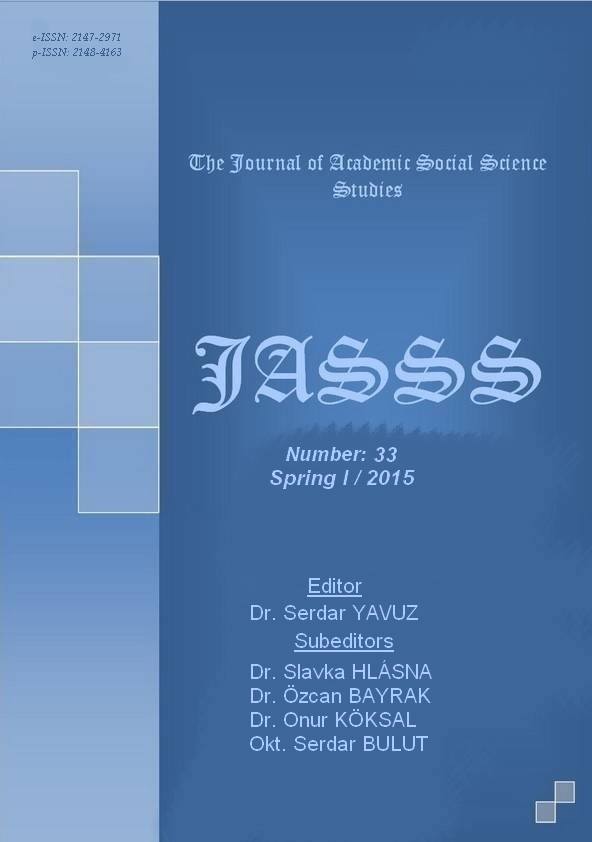Author :
Abstract
Teorik ve uygulamalı jeomorfoloji arasındaki temel konulardan biri olan jeomorfometri hakkında son yıllarda yapılan bilimsel çalışmalar oldukça artmıştır. Böylece topografyanın oluşum ve gelişim süreciyle alakalı daha sağlıklı sonuçlar elde edilebilmektedir. Bu çalışmanın amacı, KAF (Kuzey Anadolu Fayı)’ın en batı kolu olan Ganos Fayı üzerinde yer alan Hoşköy Deresi Havzasının jeomorfometrik özelliklerinin ve genç tektoniğin bölgenin morfolojik gelişimindeki rolünün açıklanmasıdır. Bu amaç kapsamında havza alanının jeomorfometrik özellikleri çeşitli jeomorfik indislerle ortaya konmaya çalışılmıştır. Çalışmada “Hoşköy Deresi Havzası’nın jeomorfometrik özellikleri nasıldır? Bu özelliklerin tektonik etkenlerle bir ilişkisi var mıdır? Bu ilişki havzanın gelişimini nasıl etkilemiştir?” şeklindeki araştırma sorularına yanıtlar aranmıştır. Çalışmanın hipotezi, akarsu havzalarının gelişimi ile drenajın kuruluş ve gelişmesinin şekillenmesinde tektonik etkenler önemli rol oynamaktadır. Çalışmanın önemi ise tektonik etkilerin bazı jeomorfometrik yöntemlerle CBS (Coğrafi Bilgi Sistemleri) teknikleri kullanılarak açıklanabileceğini göstermektir. Temel materyal olarak 1:25.000 ölçekli topografya paftaları ve bu paftalardan elde edilen SYM (Sayısal Yükseklik Modeli) ile değişik ölçeklerdeki jeoloji haritalarından yararlanıldığı bu çalışmanın yöntemini çeşitli jeomorfik indis uygulamaları oluşturmaktadır. Çalışmadaki verilerin analizleri ve haritalandırması, CBS teknikleriyle ArcInfo/ArcMap 10.2 paket programı kullanılarak gerçekleştirilmiştir. Çalışma sonucunda, havza alanı ile drenajın kuruluş ve gelişmesinin tektonik etkenler vasıtasıyla şekillendirilmiş olduğu anlaşılmıştır. Havza alanında tektonizma etkisi, Ganos Fayı’nın kuzeyinde güneyine oranla daha şiddetli olmuştur. Bu durum mansaptan membaya doğru olacak şekilde ana akarsu kolunun sağında topografyanın güneye doğru çarpılmasına ve yükselmesine, solunda ise kuzeye doğru yönlenmesine yol açmıştır. Bu çalışma topografyadaki tektonik etkilerin bazı jeomorfometrik yöntemler kullanılarak CBS teknikleriyle açıklanabileceğini göstermiştir. Bu özelliği nedeniyle CBS, topografyaya dayalı analizler ve planlamalarda etkin karar vermeye yardımcı bir araç olarak kullanılabilir.
Keywords
Abstract
The number of scientific studies on geomorphometry, which is a subject between theoretical geomorphology and practical geomorphology, has increased in recent years. Therefore, sounder results can be obtained about the formation and development process of topography. This study aims to explain the geomorphometric features of the Hoşköy River Basin, which extends on the Ganos Fault that is the westernmost branch of NAF (North Anatolian Fault), and the role of the young tectonic unit on the morphological development of the region. To this end, an attempt has been made to reveal the geomorphometric features of the basin area through various geomorphometric indices. The study has intended to answer the following research questions: “What are the geomorphometric features of the Hoşköy River Basin? Is there any relationship between these features and tectonic factors? If any, how has this relationship affected the development of the basin?”. The research hypothesis is as follows: Tectonic factors play an important role in the development of drainage basins and the formation and development of drainage. The study is significant because it shows that tectonic influences can be explained through certain geomorphometric methods via GIS (Geographic Information Systems) techniques. 1:25.000 scale topographic map sheets, DEM (Digital Elevation Model) formed based on these map sheets, and geological maps of various scales have been used as basic materials. The methodology of the present study includes various geomorphic indices. The research data have been analyzed and mapped via ArcInfo/ArcMap 10.2 through GIS techniques. According to the research results, tectonic factors have shaped the basin area and the drainage (its formation and development). The tectonic influence has been more intense in the north of the Ganos Fault in comparison to its south in the basin area. That has caused the topography to warp to the south and rise on the right side of the main tributary and to head northward on the left side of the main tributary, all occurring from downstream to upstream. The present study has indicated that tectonic influences on the topography can be explained through certain geomorphometric methods via GIS techniques. Thanks to this feature, GIS can be used as an auxiliary tool to make effective decisions in topography-based analyzes and planning.





